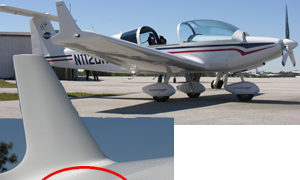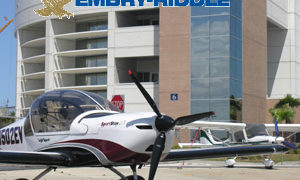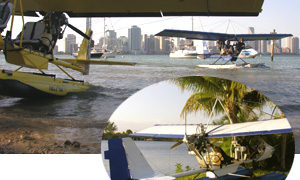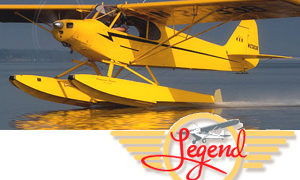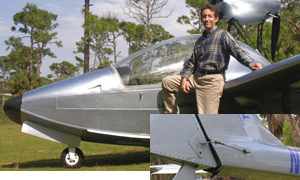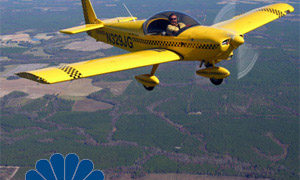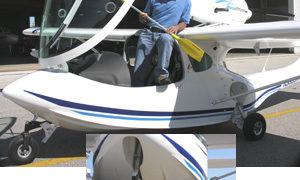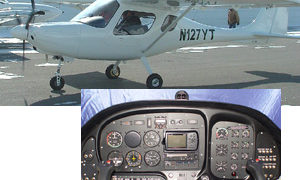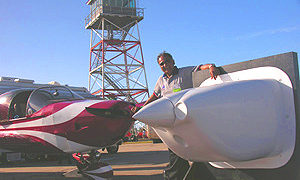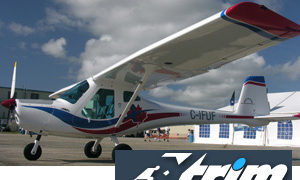When you walk up to Skylark, you get an impression that usually lasts (a marketer’s dream come true). While uncommon in light sport aviation winglets are well established on fast airplanes from bizjets to airliners. As a design feature, winglets that stick in your mind make the wingtip device a winner for sales reasons; any aerodynamic gain is icing on the cake. *** Burt Rutan is credited with first using the idea on his VariEze in 1975 and it was subsequently used by the Learjet 28 and the McDonnell Douglas MD-11. But the concept was invented even before the Wright Brothers first flight, way back in 1897. Even then they knew about wingtip vortices. Get more winglet info. Skylark has become Sportsplanes.com‘s top-of-the-line LSA, flanked by the Breezer, C42, and American Flyer. Skylark was designed by Canadian David Marsden, who engaged Dova of Czech Republic to built it, later selling them the design rights.
LSA Training Aircraft Welcomed to Embry Riddle
A month before Sun ‘n Fun helps to kick off the new year, I visited Embry Riddle Aeronautical University (ERAU) in Daytona Beach as the big aero school hosted dozens of universities at the National Training Aircraft Symposium. The third of these events to gather academia with industry invited Light-Sport Aircraft to participate. University aeronautical department leaders know general aviation best but clearly recognize LSA and value their economical operation. Plus, these are aeronautical places of learning and SP/LSA is now part of the FARs they teach. Many sessions at NTAS were highly technical, aimed at helping to prepare students for airline careers. Yet every student has to solo and simple flying machines have a secure future. “The LSA panel session was lively,” said ERAU organizers, “and the questions were good.” ERAU is one of our major educators for young aviators; their interest in LSA is timely and appropriate.
Ultralight Adventures (and More) in Downtown Miami
More than a decade ago, Tony Anderson started teaching students how to fly on floats. Today, his family enterprise spreads across three aviation businesses. In a recent visit I was most impressed to witness what the Andersons have built. From their home base with hangar right on an in-town lake to the North Perry Airport FBO to a downtown Miami seaplane operation, Tony and son Adriel have this major tropical metro covered. At North Perry they also run their FK Lightplanes USA enterprise, importing and selling the Fk9, Polaris, and Comet. On my visit the Fk9 used for training was constantly busy plus I saw two brand-new Fk9s available for immediate delivery. Across the city in downtown Miami, Tony and Adriel operate several Drifter 912s on straight Lotus floats. Adriel directs this training and intro lesson operation. He’s accumulated a rather astounding 5,000 hours in one particular Drifter and it isn’t the only aircraft he flies.
U.S. Leading Manufacturer of LSA Remains a Legend
With the delivery of their 88th Legend Cub, the Sulphur Springs, Texas-based company handily confirmed its well-out-in-front leadership among American companies building SLSA. If fact, among the entire fleet, Legend is a solid number two behind Flight Design and its CT, a good margin ahead of next-best producers Fantasy Air, TL Ultralight, Evektor, Tecnam, and AMD (according to the best info I have). Other U.S. built LSA companies include IndUS, RANS, Jabiru USA, CubCrafters, Skykits, Just Aircraft, Luscombe, Prestige, Delta Jet (trike), and Infinity (PPC). Seventeen models — a shade over a third — of 48 currently approved are either “Made in the USA” or foreign designs built in the U.S. *** All-American Legend recently listed their many achievements in less than two years since the first SLSA approvals including: Jabiru (or Continental) power, floats, glass cockpit, special paint schemes…all in addition to many Piper J-3 improvements, such as a wider cockpit, doors on both sides, and fly from either seat capability.
Famous Flying Boat; 1st Flight in the Metal Amphib
Continuing the tour of floatplanes (yes, I remember it’s winter up north even while I tour the tropical south, but what a good time to think about warmer days to come)…we paid a visit to the home field of Sport Aircraft Works. SAW is the U.S. marketing arm for Czech Aircraft Works (CZAW) and their SportCruiser, Parrot, and Mermaid. SAW proprietor Danny Defelici aided CZAW in the development of all three LSA. *** A crowning achievement was completing work on the amphibious Mermaid. I was the lucky first U.S. journalist to fly Mermaid! With its 120-hp Jabiru 3300, Mermaid performs well on land or water. Hiking up or dropping the gear is done via an easily-reached, hand-pumped hydraulic lever in the center console. Taxiing up on a beach proved effortless. Danny has taken CZAW’s Mermaid and fashioned an enjoyable amphib, coincidentally the first such to gain an FAA exemption allowing a properly trained Sport Pilot to, ahem…reposition the gear.
AMD’s CH-601 XL Goes Ballistic
For years BRS Parachutes sold emergency systems to ultralight pilots. Then along came Cirrus Design, who installed the CAPS (Cirrus Airframe Parachute System) on their SR-20 and SR-22 models as standard equipment. It was a bold and unproven tactic, but today, the SR-22 is the best selling general aviation aircraft in the world. Did the parachute help that success? “Absolutely,” says Cirrus president, Alan Klapmeier. Light-Sport Aircraft producers commonly offer parachute systems: Flight Design CT uses a BRS 1350 HS as standard equipment; TL’s StingSport comes with Galaxy. *** Now Aircraft Manufacturing and Development (AMD) has added the BRS to a long list of available safety features: Amsafe seat belt airbags, lightning protection (on the IFR certified CH-601 XLi model), Tetra foam seat cushions (to absorb “G” loads on hard touchdowns), and a FAR 33 certified aircraft engine, the Continental 0-200.
Flying Boats in Florida; Sampling SeaMax
My wife, Randee, and I are finding lots of good reasons to winter in Florida (while our home state of Minnesota gets buried in snow). Here’s three of those good reasons: SeaMax, Mermaid, and Drifter on Lotus floats. Float flying in winter is different…and fun! *** I have now flown the SeaMax three times. Yesterday we did three water and three land touchdowns. What a hot little flying boat. (Earlier SeaMax SPLOG) I use the word “little” literally…the amphib high wing LSA barely comes up to my chest and gross weight is only 1,144 pounds; LSA floatplanes can weigh 1,430 pounds. At this weight SeaMax performs brilliantly with the 100-hp Rotax 912S; 4800 rpm produces more than 100 mph. SeaMax has not yet finished its work to achieve SLSA status. But since this is the designer’s 22nd creation and as over 45 SeaMax aircraft have been sold into Europe and elsewhere, the task is not difficult, just time consuming.
First Storm Rally Assembled in the USA
Michigan-based Prestige Aircraft recently rolled out their first U.S.-built Storm Rally. Examples of this attractive high wing aircraft seen at airshows like AirVenture 2006 were manufactured by the Italian company that created the design. Now, Prestige builds the Rally under an agreement with Storm Aircraft and plans to add the low wing Century and amphibious Sea Storm in the future. *** Rally, which won its SLSA approval in early 2006, is a carbon fiber and Kevlar reinforced composite design that comes equipped with basic flight instruments and equipment for VFR day operation including a turn-coordinator; tail-strobe; ICON 200 radio; and Garmin transponder with an altitude encoder. Unlike many other brands, national distributor Air Elite Aviation says, “All aircraft models come with a limited two-year, or 1000-hour warranty.” Rally can cruise at 107 knots (75% power) and, with 34 gallons of usable fuel, it boasts an 800 nautical mile range.
Nose Job and New Boots for Thorpedo LP
How to extract more performance from a 60-year-old design? How about a nose job? Pilots understand a smoother shape lends more speed to a design, but you may not sense the total gain possible without adding horsepower or burning more fuel. General aviation companies like Mooney, Cessna, and Piper hired LoPresti Speed Merchants to help boost speed. *** At the 2007 Sebring LSA Expo IndUS Aviation revealed a new LoPresti nose cowl for their Thorpedo LP; plus reshaped wing tips which enclose nav and landing lights plus strobes, and new landing gear fairings…which, being Texans, they called “cowboy boots.” LoPresti engineers say the streamlined improvements will boost Thorpedo’s speed near the LSA limit of 120 knots. A 75% power cruise gain of 20% is forecast. The new components modernize the lines of this venerable John Thorp design from the 1940s, though it may seem hard to improve on a airplane that never required a single Airworthiness Directive!
Delightful-to-Fly Light-Sport Aircraft from Poland
Much attention on LSA seems to focus on U.S.-built aircraft or those from Czech Republic. Of course we have many other countries contributing to the growing U.S. fleet including Germany, Italy, and Australia. While Poland also contributes fabrication to the German-designed FK Lightplane series, the country isn’t widely known to Americans as an LSA provider. Its fuselage boom with vertical flanges (assembled from two fuselage halves) shows how this airplane descends from sailplane gliders built for many years in Eastern Europe. Imported by Rainbow Sport Aviation in Canada, the creator of the 3X55 is Adam Kurbiel, who designed gliders at the SZD-PZL glider factory before turning his attention to light airplanes. A modest cruiser (88 knots or 101 mph at 75% power), 3X55 handles beautifully and lands easily. The 47-inch-wide interior is nicely appointed with modern controls to match more expensive aircraft. Priced at $73,500 with the 80-hp Rotax, 3X55 seems a relative bargain.
- « Previous Page
- 1
- …
- 57
- 58
- 59
- 60
- 61
- …
- 64
- Next Page »


